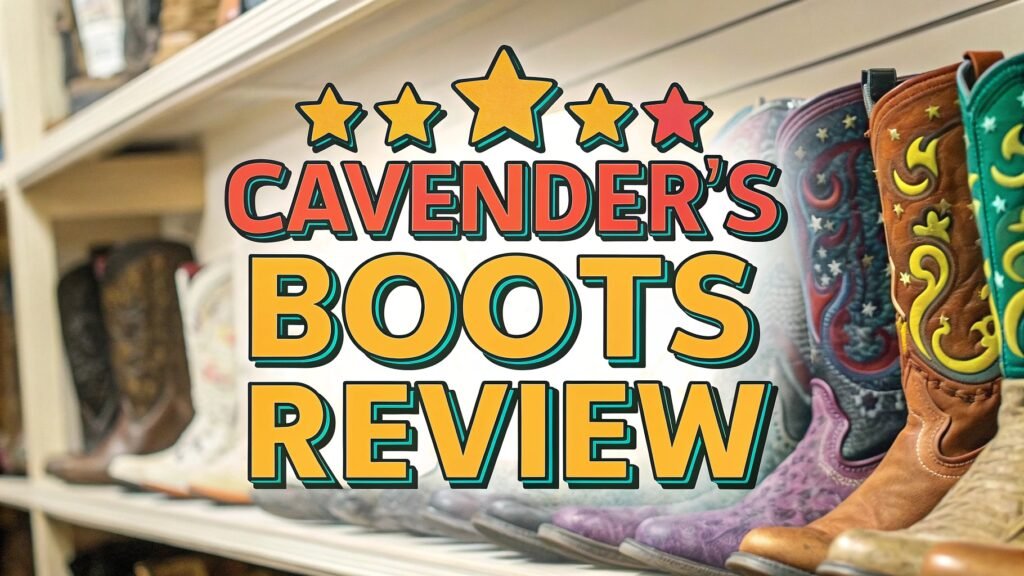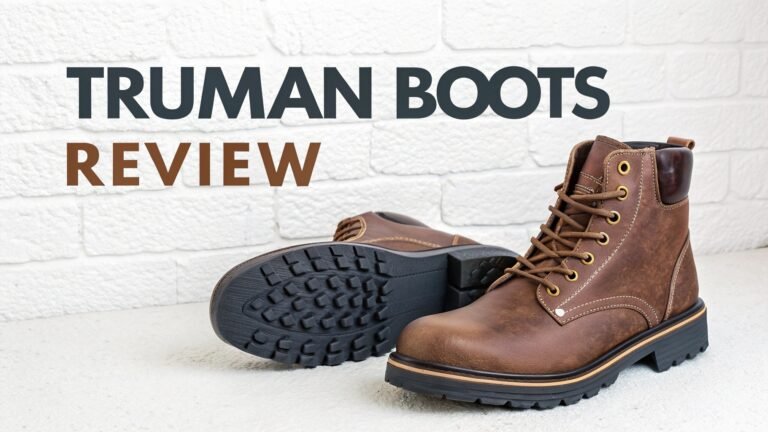Cavender’s Boots Review: Quality, Comfort, and Western Heritage
Cavender’s boots have earned a solid reputation in the western footwear industry for over 50 years. These boots combine traditional craftsmanship with modern comfort technologies.
Many customers choose Cavender’s for their first pair of western boots. The brand offers affordable options without compromising essential quality features.
This comprehensive review explores everything you need to know about Cavender’s boots.

Key Takeaways:
- Affordable Quality: Cavender’s boots typically range from $129 to $429, offering genuine leather construction at competitive prices compared to premium brands like Lucchese or custom bootmakers
- Wide Size Selection: The brand excels in providing extended sizing options, particularly in EE widths, making them accessible for customers with wider feet who struggle to find proper fits elsewhere
- Mixed Construction Materials: While featuring genuine leather, many Cavender’s models incorporate synthetic materials to reduce costs, which some purists may view as a compromise on traditional boot construction
- Comfort-Focused Design: Models feature removable cushioned insoles and supportive shanks, prioritizing all-day wearability for working professionals and casual wearers alike
- Free Boot Stretching Service: Cavender’s offers complimentary in-store stretching services to help customers achieve perfect fits, addressing common sizing concerns with western boots
- 30-Day Return Policy: The company provides a reasonable return window for exchanges, though boots must remain in as-new condition with unscratched soles for full refund eligibility
What Makes Cavender’s Boots Special
Cavender’s boots stand out through their focus on accessibility and comfort. The company understands that many customers are new to western boots. They design their products to ease the transition from regular footwear. Traditional western boot makers often prioritize authentic construction over immediate comfort. Cavender’s takes a different approach by incorporating modern comfort features.
The brand’s heritage dates back to 1965 when the Cavender family started their western wear business. This experience shows in their understanding of customer needs. They know that comfort matters as much as style for most buyers. Their boots feature supportive footbeds and cushioned insoles that many traditional brands overlook.
Manufacturing partnerships allow Cavender’s to offer competitive pricing. They work with established boot makers to produce their private label products. This approach keeps costs reasonable while maintaining quality standards. The result is boots that deliver solid performance without premium pricing.
Construction and Materials Used in Cavender’s Boots
Cavender’s boots utilize genuine leather construction for their uppers and linings. The leather quality varies across different price points. Entry-level models feature corrected grain leather that provides durability at lower costs. Higher-end options use full-grain leather that develops character over time.
Synthetic materials appear in various components to control manufacturing costs. These include certain sole materials and some internal support structures. While purists prefer all-leather construction, these synthetics improve affordability without significantly impacting performance. The combination allows Cavender’s to serve budget-conscious customers effectively.
Stitching quality remains consistent across their product line. The brand uses double-stitched seams in high-stress areas. This construction method enhances durability and prevents premature failure. Welt construction varies by model, with some featuring Goodyear welts while others use cement construction for cost efficiency.
Sole materials include both leather and rubber options. Leather soles provide traditional feel and breathability. Rubber soles offer superior traction and durability for work environments. Many models feature oil-resistant outsoles that perform well in various conditions.
Cavender’s Boot Sizing and Fit Guide
Cavender’s boots follow traditional western boot sizing conventions. They typically run half a size larger than regular shoe sizes. This accounts for the boot’s construction and intended wearing style. First-time western boot buyers should consider sizing down from their sneaker size.
Width options extend beyond standard D widths. Cavender’s excels in providing EE and EEE widths for customers with wider feet. This focus on extended sizing sets them apart from many competitors. Proper width selection significantly impacts comfort and long-term foot health.
The brand offers free in-store stretching services to address fitting issues. Professional boot stretching can accommodate minor size discrepancies and pressure points. This service adds value to the purchasing experience. Customers should try boots on carpeted surfaces only to maintain return eligibility.
Shaft heights vary from 11 inches to 16 inches depending on the model. Calf circumference measurements help ensure proper shaft fit. Boots should allow one to two inches of space around the calf for comfortable movement. Proper fitting prevents circulation issues and discomfort during extended wear.
Popular Cavender’s Boot Styles and Models
The Intrepid Collection represents Cavender’s most popular casual western boots. These models feature eye-catching exotic prints and modern comfort features. Prices typically range from $129 to $189 for most colorways. The collection appeals to fashion-conscious customers seeking stylish western looks.
Horseman and Ranchero lines target working professionals and traditional western enthusiasts. These boots emphasize durability and classic styling over trendy features. Leather quality in these lines typically exceeds entry-level options. Pricing reflects the enhanced materials and construction methods used.
Women’s collections include specialized fits and feminine styling details. Snip toe designs remain popular among female customers. The brand offers various heel heights to accommodate different preferences. Embroidered details and decorative stitching enhance the aesthetic appeal of women’s models.
Work boot options feature safety certifications and enhanced durability. These models include steel toe protection and slip-resistant outsoles. While maintaining western styling, safety features meet occupational requirements. Pricing for work boots typically starts around $159 for basic models.
Top 3 Alternatives to Cavender’s Boots
When considering alternatives to Cavender’s boots, three brands consistently deliver exceptional quality and value in the western footwear market.
Tony Lama boots represent the gold standard for traditional western craftsmanship. These boots feature premium leather construction and time-tested manufacturing techniques. Tony Lama’s pricing typically ranges $200 to $400 for standard models. Their reputation for durability makes them excellent long-term investments.
Justin Boots offers excellent middle-ground options between budget and premium categories. The brand combines traditional styling with modern comfort features. Justin’s work boot line particularly excels in occupational settings. Pricing generally falls between $150 to $300 depending on features and materials.
Ariat boots emphasize performance and innovation in western footwear. Their advanced sole technologies provide superior comfort for long days. Ariat’s athletic-inspired features appeal to younger customers. The brand typically prices between $160 to $350 for western styles.
Comfort and Performance Analysis
Comfort levels in Cavender’s boots receive mixed customer feedback. Many users praise the immediate wearability compared to traditional western boots. The cushioned insoles and supportive shanks reduce break-in time significantly. However, some customers report durability concerns with comfort features over extended use.
All-day wearability varies by individual foot shape and intended use. Office workers and light-duty users generally report positive comfort experiences. Heavy-duty workers may find the comfort features insufficient for demanding environments. Proper sizing significantly impacts overall comfort levels.
Moisture management capabilities depend on leather quality and construction methods. Full-grain leather models breathe better than corrected grain options. Synthetic components may reduce breathability in some areas. Proper sock selection helps optimize moisture control and comfort.
Support characteristics include arch support and heel stability. The removable insoles allow for custom orthotic use when needed. Ankle support varies by shaft height and personal preferences. Most users find adequate support for casual and moderate work applications.
Durability and Longevity Assessment
Construction quality directly impacts boot longevity expectations. Higher-priced Cavender’s models typically last longer than entry-level options. Customer reports suggest 12 to 24 months of regular use for basic models. Premium constructions may extend usability to 3 to 5 years with proper care.
Sole wear patterns vary significantly based on usage intensity and surface conditions. Rubber soles generally outlast leather options in harsh environments. Resoling options depend on construction methods used. Goodyear welted models allow for professional resoling when needed.
Upper leather durability correlates with leather grade and thickness. Full-grain leather uppers develop character while maintaining structural integrity. Corrected grain options may show wear patterns more quickly. Proper conditioning extends leather life significantly.
Component failure points typically include sole attachment and stitching stress areas. Quality control variations can affect individual boot performance. Warranty coverage provides some protection against manufacturing defects. Proper care and maintenance maximize boot lifespan regardless of initial quality.
Price Range and Value Proposition
Entry-level Cavender’s boots start around $129 to $159 for basic leather models. These options provide genuine western styling at accessible price points. Value-conscious customers find these boots suitable for occasional wear and light duties. Construction compromises become apparent with heavy use.
Mid-range models typically cost $169 to $219 and offer improved materials and features. This price segment represents the sweet spot for most casual users. Better leather quality and enhanced comfort justify the price increase. Durability improvements make these options more cost-effective long-term.
Premium Cavender’s boots range from $279 to $429 and feature exotic leather options. These models compete directly with established western boot brands. Construction quality approaches traditional bootmaker standards. Limited edition designs may command premium pricing.
Comparative value analysis shows Cavender’s boots compete well in the budget segment. However, traditional brands often provide better long-term value despite higher initial costs. Cost-per-wear calculations favor quality boots for frequent users. Occasional wearers benefit from Cavender’s affordability.
Customer Reviews and Satisfaction Ratings
Overall customer satisfaction with Cavender’s boots receives mixed to positive ratings. First-time western boot buyers generally express satisfaction with comfort and style. Experienced users sometimes note quality differences compared to premium brands. Expectations management significantly influences satisfaction levels.
Comfort ratings consistently receive positive mentions in customer feedback. Many reviewers highlight immediate wearability without extended break-in periods. Cushioned insoles and supportive construction earn particular praise. Some users report comfort degradation over time with heavy use.
Durability feedback varies significantly based on usage patterns and model selection. Light-duty users report satisfactory longevity for the price point. Heavy-duty applications reveal construction limitations more quickly. Sole separation and stitching failures appear in some negative reviews.
Sizing accuracy receives generally positive feedback with some notable exceptions. Width options earn praise from customers with fitting challenges. Length sizing occasionally runs inconsistent between models. In-store fitting services help address sizing concerns effectively.
Care and Maintenance Requirements
Proper leather conditioning extends boot life significantly regardless of initial quality. Monthly conditioning maintains leather flexibility and appearance. High-quality leather conditioners work better than generic products. Over-conditioning can damage leather so moderation remains important.
Cleaning procedures vary by leather type and finish. Smooth leather responds well to standard saddle soap and leather cleaners. Exotic leathers may require specialized cleaning products. Regular brushing removes surface dirt and maintains appearance between deep cleanings.
Storage practices significantly impact boot longevity and shape retention. Cedar boot trees help maintain proper shape during storage. Climate-controlled environments prevent leather cracking and warping. Rotation between multiple pairs allows proper drying and reduces wear.
Professional maintenance services include resoling and repair options. Goodyear welted models accept professional resoling more readily. Local cobbler capabilities vary so research helps identify quality services. Preventive maintenance costs less than major repairs or replacement.
Pros and Cons of Cavender’s Boots
Advantages include affordable pricing that makes western boots accessible to budget-conscious customers. Extended sizing options accommodate customers with fitting challenges. Immediate comfort reduces traditional western boot break-in requirements. Free stretching services add value to the purchase experience.
Wide model selection provides options for various style preferences and applications. Established retail presence offers convenient try-on opportunities. Reasonable return policies protect customers from sizing mistakes. Modern comfort features appeal to contemporary users.
Disadvantages include construction compromises necessitated by competitive pricing. Synthetic material usage may disappoint traditionalists seeking all-leather construction. Durability limitations become apparent with heavy use applications. Quality inconsistencies occasionally affect customer satisfaction.
Limited resoling options for cement-constructed models reduce long-term value. Brand perception lacks the prestige associated with traditional western boot makers. Style limitations may not satisfy customers seeking unique or custom features.
Where to Buy Cavender’s Boots
Cavender’s retail stores provide the optimal purchasing experience with professional fitting services. Trained staff can recommend appropriate models and sizing. In-store stretching services address fitting concerns immediately. Product availability varies by location and seasonal demand.
Online purchasing offers convenience and broader selection but requires careful sizing consideration. Return policies allow exchanges for sizing issues. Customer reviews on retail websites provide additional product insights. Seasonal sales often provide significant discounts on select models.
Authorized retailers including Boot Barn and Sheplers carry select Cavender’s models. Price consistency remains generally stable across authorized dealers. Local western wear stores may stock limited selections. Specialty boot stores sometimes offer professional fitting services.
Secondary markets including consignment shops and online auctions offer used options. Condition assessment requires careful evaluation for used purchases. Authentication concerns arise with high-value exotic models. Warranty coverage typically doesn’t transfer to second owners.
Comparison with Competitor Brands
Ariat boots generally offer superior technology integration and performance features. Price points overlap significantly with Cavender’s premium models. Athletic-inspired comfort appeals to active users. Brand reputation carries more weight in professional equestrian circles.
Justin Boots provides better construction quality at comparable price points. Traditional styling appeals to western heritage enthusiasts. Resoling capabilities enhance long-term value propositions. Manufacturing consistency typically exceeds Cavender’s standards.
Tony Lama boots represent premium western craftsmanship with corresponding price premiums. Leather quality significantly exceeds Cavender’s standards. Construction methods follow traditional bootmaking practices. Longevity expectations justify higher initial investments for frequent users.
Boot Barn private label offers similar positioning to Cavender’s with competitive pricing. Quality levels appear comparable across similar price ranges. Selection variety varies by retailer focus and customer base. Value propositions remain similar for budget-conscious customers.
Final Verdict and Recommendations
Cavender’s boots serve specific market segments effectively despite some limitations. First-time western boot buyers benefit from the affordable pricing and immediate comfort. Occasional users find adequate quality for their needs. Budget-conscious customers appreciate the accessible western styling.
Working professionals should consider higher-end models or alternative brands for demanding applications. Quality expectations should align with pricing levels to avoid disappointment. Long-term value favors premium brands for frequent users. Proper sizing and care maximize satisfaction regardless of brand choice.
Recommendation categories help guide purchasing decisions. Casual wear applications suit most Cavender’s models well. Light work duties can be accommodated with appropriate model selection. Heavy-duty applications require careful consideration of construction quality and durability expectations.
Purchase timing can significantly impact value received. End-of-season sales offer substantial savings on select models. New model introductions often coincide with discounts on existing inventory. In-store promotions may include free accessories or services that enhance overall value.
Frequently Asked Questions
Are Cavender’s boots good quality for the price?
Cavender’s boots offer solid quality for their price range, particularly in the $150-$200 category. They use genuine leather construction and include comfort features that many budget brands lack. However, construction compromises become apparent when compared to premium brands. For occasional wear and light duties, they provide excellent value. Heavy-duty users might find better long-term value with higher-priced alternatives.
How do Cavender’s boots fit compared to regular shoes?
Cavender’s boots typically run about half a size larger than athletic shoes due to western boot construction standards. First-time western boot buyers should consider sizing down from their sneaker size. The brand excels in width options, particularly EE and EEE widths for customers with wider feet. Professional fitting at Cavender’s stores helps ensure proper sizing, and they offer free stretching services to address minor fit issues.
What is the break-in time for Cavender’s boots?
Break-in time varies significantly depending on the model and leather type. Most customers report minimal break-in requirements compared to traditional western boots, often just 2-3 days of regular wear. The cushioned insoles and softer leather reduce initial discomfort. However, exotic leather models may require longer break-in periods. Proper sizing significantly reduces break-in discomfort and duration.
Can Cavender’s boots be resoled?
Resoling capability depends on construction method used in specific models. Goodyear welted models can typically be resoled by qualified cobblers, extending boot life significantly. However, many Cavender’s boots use cement construction which limits resoling options. Higher-priced models more likely feature resole-friendly construction. Local cobbler expertise varies, so research quality repair services in your area before purchasing.
How long do Cavender’s boots typically last?
Durability expectations range from 12-24 months for entry-level models with regular use to 3-5 years for premium constructions with proper care. Usage intensity significantly impacts longevity – office wear extends life compared to ranch work. Leather quality and construction methods determine maximum lifespan potential. Proper conditioning and rotation between multiple pairs maximizes durability regardless of initial quality level.
What makes Cavender’s different from other western boot brands?
Cavender’s focuses on accessibility and immediate comfort rather than traditional western boot conventions. They incorporate modern comfort technologies like cushioned insoles and supportive shanks. Extended sizing options, particularly in wider widths, set them apart from many competitors. Competitive pricing makes western styling accessible to budget-conscious customers. However, construction compromises differentiate them from premium traditional bootmakers who emphasize longevity over immediate comfort.
Hi i’m Mia Jenkins a fashion trend expert with a passion for self-expression and creativity. With a keen eye for style and a deep understanding of the latest trends.






